 |
William Birch, The Entrance to Springland, ca. 1800. Watercolor, ink, and pencil. Library Company of Philadelphia.
Visitors arriving by land would enter the property through this entrance. The entryway is noted in the upper left of the overall plan also on exhibit. The Porter’s Lodge is probably the roof visible over the tall fence. |
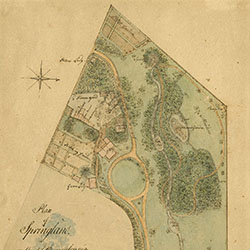 |
William Birch, Plan of Springland, near Bristol, Pennsylvania, ca. 1800. Watercolor, ink, and pencil. Library Company of Philadelphia.
Birch envisioned an impressive arrival for visitors to Springland. A path to a circular drive would lead guests arriving by water or land to the front of his residence and the adjacent “Green Lodge,” the building housing his extensive art collection. A grove of trees would surround his nearby painting studio. The plan incorporated practical features of a working rural residence, including a granary, hen house, and pig sty along with more picturesque elements such as “Neptune’s Garden” with a grotto. |
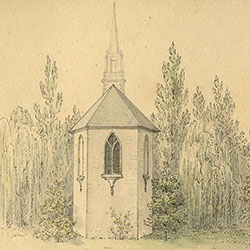 |
William Birch, [View of the Chapel/Smokehouse at Springland, with Steeple Detail and Plan], ca. 1800. Watercolor, ink, and pencil. Library Company of Philadelphia.
Birch seems to propose a multipurpose building in this sketch, but the building does not appear in his overall plan of Springland. |
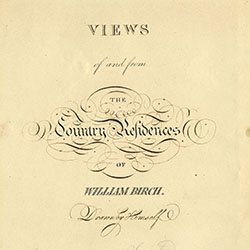 |
William Birch, Views of and from the Country Residences of William Birch Drawn by Himself, ca. 1800. Ink and pencil. Library Company of Philadelphia. Gift of Clarence Wolf.
Birch added the note “with a sett of Drawings of Springland” to this title page from his personal sketchbook. All of the watercolors in this exhibition section came from this sketchbook which was disbound sometime before its sale at auction in 1980. Among the artwork originally included were Birch’s views of the Neshaminy Creek from the fish pond, an aviary complete with a Gothic-style birdhouse, and the lush greenery seen from the window of Green Lodge. The beauty of the surroundings also inspired William’s daughter Priscilla, an artist in her own right, to paint a watercolor in the sketchbook entitled The Natural Produce of Springland. |
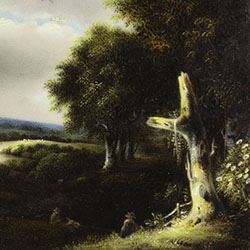 |
William Birch after Jacob van Ruisdael, [Stump], 1815. Enamel on copper. Private Collection.
Birch noted on the back of this miniature that he painted it at Springland after a painting in his possession. He described the painting as “one of the choicest pictures of that master.” The Metropolitan Museum of Art owns another enamel on copper of this painting executed by Birch. |
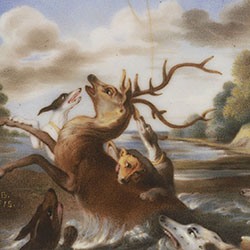 |
William Birch after Ross, Death of the Stag, 1815. Enamel on copper. Philadelphia Museum of Art: Gift of Mr. and Mrs. James Crawford Hornor, 1993.
Birch praised the original painting by Ross in his collection by writing: “The fiery animation of the dogs, the expression of fear in the countenance of the stag, the grouping of the subject in the water, with a fine landscape, marks its excellence.” |
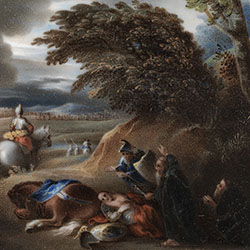 |
William Birch after Joseph Parrocel, After the Battle, 1817. Enamel on copper. Courtesy of the Pennsylvania Academy of the Fine Arts. Bequest of Constance A. Jones.
“The colouring is brilliant and the composition sublime,” Birch declared in describing the original late 17th-century painting in his catalog of artwork at Green Lodge. |
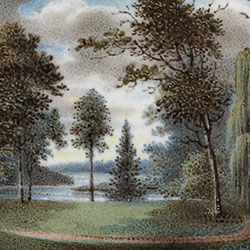 |
William Birch, Springland: The Artist’s Residence, ca. 1800. Enamel on copper (set as pin). Courtesy of the Pennsylvania Academy of the Fine Arts. Gift of John M. Staney. |

|
William Birch, Birch’s American Cottage, Vol. 2nd. Library Company of Philadelphia.
At Green Lodge on the Springland grounds, Birch assembled a collection of primarily European paintings and prints in the hope of elevating his visitors’ and America’s taste for the fine arts. Included in this volume is the inventory of these works of art with Birch’s commentary on what made them worthy of inclusion. |
 |
William Birch, A Grub Found on the Virginia Spice Wood in Springland, ca. 1800. Watercolor, ink, and pencil. Library Company of Philadelphia.
What Birch called Virginia spice wood is most likely American spicebush (Lindera benzoin), an ornamental shrub common in the mid-Atlantic region. The plant’s springtime yellow flowers are followed by small, bright red fruit in autumn. |
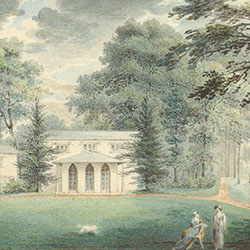 |
William Birch, Springland, ca. 1800. Watercolor, ink, and pencil. Collection of Richard Wood Snowden.
To the left of Birch’s residence stands Green Lodge where he exhibited his art collection. Birch described his holdings as “one of the finest Collections of Flemish Pictures in the country,” but he found few who appreciated his connoisseurship. General Charles Carnan Ridgely (1760-1829), a subscriber to The City of Philadelphia and whose home was documented in The Country Seats, was one of the few. Birch proudly noted in his autobiography that when Ridgely visited Green Lodge, he “had never been so struck with Pictures before.” |
 |
William Birch, View from Springland Cot., NaShaminy, ca. 1800. Watercolor. Library Company of Philadelphia. Bequest of Charles A. Poulson.
According to an obituary for Thomas Birch (1779-1851), the two-roomed toll-taker’s house, visible on the bridge over the creek, served as the studio where father and son produced the views for The City of Philadelphia. |
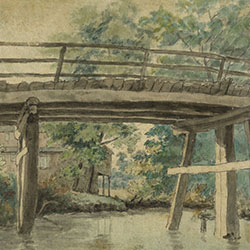
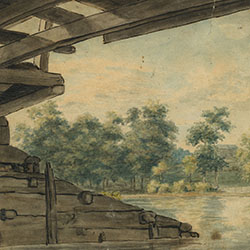
|
Attributed to William Birch, [Views on the Neshaminy Creek], ca. 1800. Watercolor, ink, and pencil. The Historical Society of Pennsylvania.
These views most likely show the abandoned toll bridge near Birch’s Springland property. |














